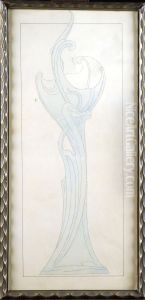Victor Horta Paintings
Victor Horta was a prominent Belgian architect and designer, who is considered one of the founders of the Art Nouveau movement. Born in Ghent on January 6, 1861, Horta began his education in music but quickly shifted his focus to architecture, enrolling at the Académie Royale des Beaux-Arts in Brussels at the age of seventeen.
During his early career, Horta was influenced by the work of French architect Eugène Viollet-le-Duc and the English Arts and Crafts movement. However, he soon developed his own style, characterized by a harmonious blend of form, function, and materials, which distinguished his work from that of his contemporaries and marked the emergence of Art Nouveau in architecture.
Horta's breakthrough came with his design of the Hôtel Tassel in Brussels, completed in 1893. This building featured innovative use of iron and glass, undulating lines, and attention to detail that would become hallmarks of the Art Nouveau style. The Hôtel Tassel, along with Horta's later works such as Hôtel Solvay, Hôtel van Eetvelde, and his own house and studio (now the Horta Museum), are considered masterpieces and have been designated UNESCO World Heritage Sites.
Throughout his career, Horta continued to push the boundaries of architectural design, integrating modern materials like steel and glass into his buildings and combining them with natural forms and decoration. His work not only influenced the development of Art Nouveau architecture in Belgium but also had a significant impact on the international scene.
After World War I, public taste shifted away from Art Nouveau, leading Horta to adapt his style towards a more restrained, geometric form of architecture, often associated with Art Deco. Despite the change in style, Horta's legacy as a pioneer of modern architecture remained intact.
Victor Horta died on September 8, 1947, in Brussels, leaving behind a body of work that continues to be celebrated for its innovation, elegance, and influence on the evolution of modern architecture. His approach to design, which emphasized the unity of architecture and decorative arts, remains a seminal force in the history of architecture.
